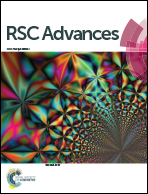Criteria for the selection of a support material to fabricate coated membranes for a life support device†
Abstract
Life support devices, specifically vacuum desiccant cooling devices require hydrophobic micro-porous membranes with high liquid entry pressure of water (LEPw), high mechanical strength and large vacuum distillation flux in the temperature range of 10–30 °C. To achieve this goal, membranes were prepared by casting polyvinylidene fluoride (PVDF) on various non-woven fabric (NWF) materials using the immersion precipitation technique at ambient temperature. Four porous polyester NWF materials were tested as the membrane support materials which were characterized by SEM analysis and by measuring the contact angle and porosity. The PVDF coated membranes were also characterized by SEM image analysis and LEPw. Finally, the coated membranes were tested for vacuum membrane distillation (VMD) performance at a relatively low feed temperature of 30 °C. The results of this study revealed a significant impact of the NWF materials on VMD performance. A suitable NWF material leads to a much enhanced VMD flux of the PVDF coated membrane that was approximately 15 times that of the unsupported PVDF membrane. These results suggest that the spongy-like layer may have strong impacts on the flux of membrane distillation. The studies provide understanding of the VMD phenomenon and provide new insights for the development of coated membranes used for life support devices.


 Please wait while we load your content...
Please wait while we load your content...